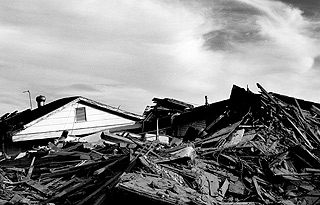Novelist Elizabeth McCracken is just back from New Orleans, where she was a writer-in-residence at the Newcomb Institute. She traveled with her husband, Edward Carey, and with Gourmet correspondent Ann Patchett. This post is the first in a series.
On our first full day in town, we went on a "devastation tour" with Crystal Kile, one of my hosts at the Newcomb. Even at a distance, safe again in Saratoga Springs, New York, I'm struggling for adjectives to describe what we saw. I can describe myself after the tour—awestruck, astonished, appalled—but the actual ruin is harder. No photograph can capture it, neither still nor moving: Everyone knows that ghosts don't show up on film.

We saw the yellow shotgun house in the Marigny where the filmmaker Helen Hill lived with her husband, Paul Gailiunas, and their son, Francis, where on January 9 she was shot and killed—only one of the 32 murders in New Orleans so far this year. We drove through neighborhoods where the only evidence of damage on the houses was the protoplasmic high-water mark at three or four or six feet high (which means that anything left in the houses below that line was ruined). This was a few weeks after Mardi Gras, and the trees on the main streets were all chandeliered with cheap beads. We drove through Gentilly, St. Bernard Parish, and into the Lower Ninth Ward, whose houses (some occupied but plenty abandoned) bore the same tattoo, a spray-painted international orange X with the date searched, the number of occupants, the number of bodies found.
Crystal doesn't think they're done finding bodies. The Lower Ninth is a murdered neighborhood, houses washed out by the failure of the levee on the Industrial Canal. Some have been gutted, and some seem to sit where the water picked them up and left them. Nearby Chalmette, hit nearly as hard, is salted with white FEMA trailers, but in the Lower Ninth we passed by block after block of houses whose occupants seemed gone, dead, or moved away for good—though there was one woman standing on the porch of what seemed like a miraculously renovated house, four chairs on the lawn and a moving van parked out front. I'm still thinking about her. What is her life going to be like?
And then we went back uptown, where we were staying, and it was as though in the previous hours we had traveled not a city but a continent, from Eastern European slums to glittering clean Scandinavian cities. We needed groceries and finished the day at the vast, very busy Whole Foods on Magazine Street, where the perfect cut flowers and stacks of produce seemed awful and disorienting.
We were glad to have gone on the tour—there's a terrible adjective, glad, but it's all I've got—for a reason I hadn't expected: We ended up having a great time in New Orleans.
The magnolia trees were in bloom, for Pete's sake. We stayed in someone's converted carriage house near Magazine Street, where we wandered and ate fried oysters at Casamento's and bowls of gumbo at a place called Ignatius. We browsed Octavia Books, one of the nicest independent bookstores I've ever been in. Shopkeepers asked us where we were from and said, wistfully, that they needed more of us. We went with friends to a neighborhood joint called Cafe Atchafalaya, which was so good that when my friend Ann's plane was delayed a few days later, I called up to see whether they were still serving. This is one of the many minor ways that New Orleans has changed: It's harder to eat out late.
"What time is it?" the guy said.
"Not sure," I said.
"Nine-thirty? If we showed up now, would you give us dinner?"
"Oh," he drawled, "I 'magine so." And he did, and it was great.
It's a funny thing, having fun in New Orleans these days, especially because New Orleanians will ask you, worriedly, whether you're having fun. You feel guilty for having a good time, all things considered, and then you assure yourself that it's your DUTY to have a good time, for New Orleans's sake. Though it seemed frivolous to get a pedicure, Ann and I did.
Hard to Let the Good Times Roll continues tomorrow.
Emergency Communities is a non-profit organization that employs compassion and creativity to provide community-based disaster relief.


 Pinterest
Pinterest


